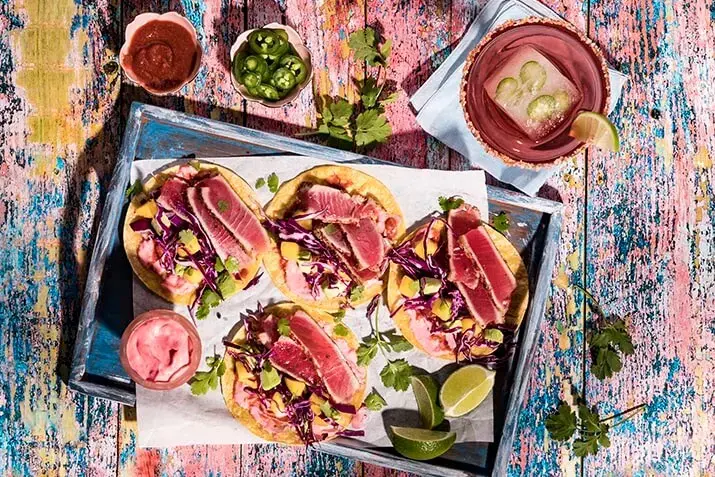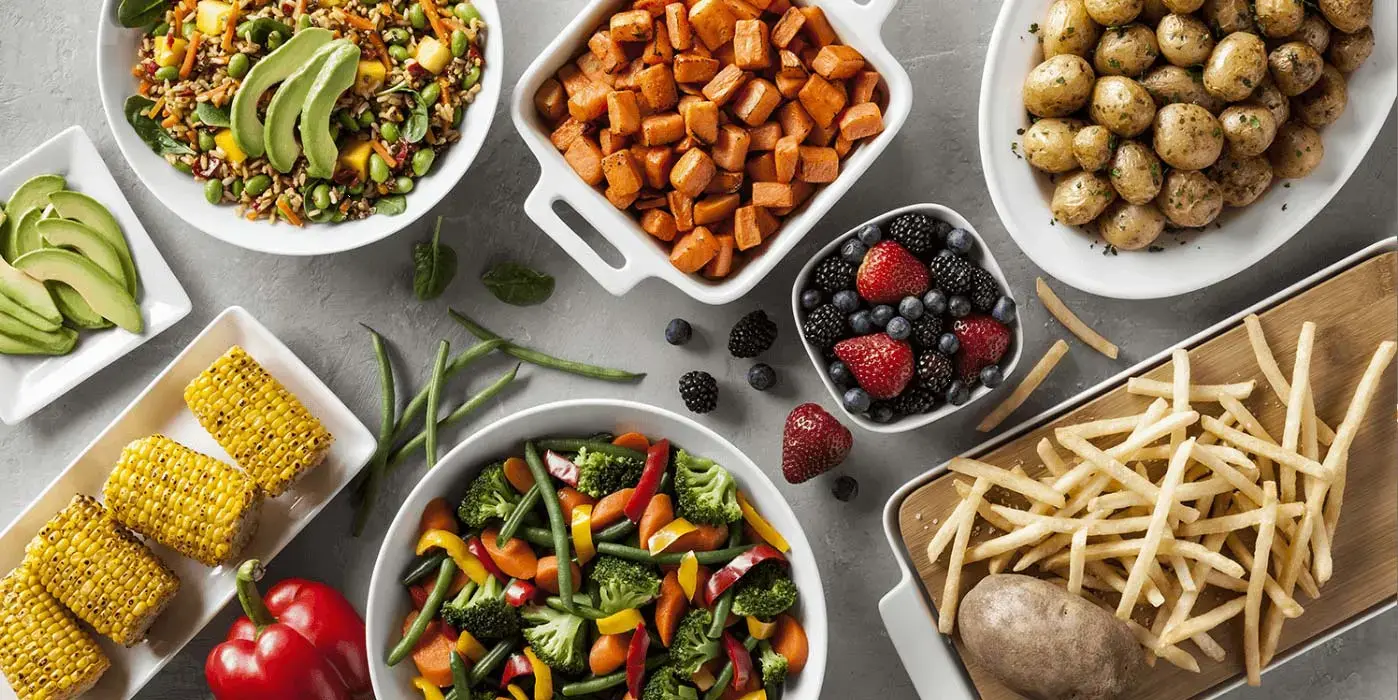Food Trends
Top 10 Food Trends for 2024: What to Look for Next
12/14/2023

As the calendar flips to 2024, an array of trends is set to redefine how we experience and interact with food. From innovative late-night snacks to the resurgence of lavish breakfasts, the dining landscape is evolving in unprecedented ways.
In this exploration, we delve into the heart of these changes, examining how they are poised to influence the way we think about, prepare, and enjoy food. Join us on this journey into the future of foodservice with our top picks for the trends shaping 2024.
1. Late-night snacks will be a big draw for younger diners and revenue growth
While total p.m. snack traffic remained stable in the third quarter of 2023, there was a distinct uptick in the evening snack segment, which saw a 4% growth.1 This increase was particularly pronounced between 1 a.m. and 6 a.m., which has witnessed growing traffic as food chains extended their hours to attract a younger demographic.1
The late-night trend is not just about satisfying late-night cravings but also reflects changing consumer patterns and lifestyles. The evening snack window over-indexes among consumers younger than 35 with incomes below $25K, a demographic that increasingly opts for convenient carry-out and delivery options.1 This underscores a broader trend within the foodservice industry, where adaptability and responsiveness to consumer habits, especially among younger demographics, are key drivers of growth and innovation.
2. The move towards more extravagant breakfasts
The "bougie" breakfast trend—a shift towards more extravagant and indulgent morning meals—is reshaping the day's first meal. A growing share of occasions increasingly favor morning meals during weekdays and weekends.2 This trend points to a desire for more satisfying and elaborate breakfast experiences despite having a lower average check historically than other meals.
Furthermore, while overall morning meal traffic remained stable in the third quarter of 2023, there was a notable increase in brunch traffic, which grew by 6%.2 This surge in brunch popularity reflects a growing interest in more sophisticated, leisurely morning dining experiences, especially on weekends.
3. Viral secret menu items: Repurposing ingredients for new LTOs
The allure of secret menu items is rapidly becoming a staple in the restaurant industry, particularly in limited-service restaurants (LSRs). This trend capitalizes on the excitement and exclusivity of discovering and trying out special, often hidden, menu options.
A significant driver behind this phenomenon is customer engagement, with 54% of LSR users expressing a keen interest in accessing special menu items as part of loyalty programs.3 This preference underscores a growing desire for personalized and unique dining experiences.
On the operational side, the trend aligns well with the practical realities of LSRs' inventory management. A mere 20% of LSR operators purchase new ingredients monthly or more frequently.3 So, repurposing existing ingredients to create these limited-time offerings (LTOs) is both cost-effective and a clever way to drive traffic.
4. One-handed meals: The appeal of easy-to-handle menu items
As lifestyles resume their pre-pandemic pace, the grab-n-go trend in the foodservice industry is witnessing a significant resurgence. This movement caters to the increasing number of consumers seeking convenient, on-the-go meal options that they can easily consume while multitasking or traveling.
According to a Datassential LSR Keynote:3
29% of consumers are visiting QSRS more often than they were a year ago.
28% of consumers report that convenience is their #1 primary motivator in choosing a QSR.
Drive-thru lanes have become the most preferred service format in limited-service restaurants.
1 in 5 visits to a QSR is eaten in a car.
The trend extends beyond traditional fast-food establishments, with 31% of consumers increasing their purchase of prepared food offerings from supermarkets compared to the previous year.4 This collective movement towards convenient dining solutions reflects a broader change in consumer habits and preferences, prioritizing efficiency and mobility in meal consumption.
5. Embracing speed scratch products to keep labor manageable
In the current foodservice landscape, "speed scratch" is gaining acceptance as a strategic response to persistent labor issues. Despite rising wages, operators continue to find that good help is hard to find.
Labor costs, a perennial challenge, are at the forefront, with 55% of operators looking for ways to economize on this front.5
60% of operators are seeking products that help reduce food waste and minimize loss, addressing both environmental concerns and cost efficiency.5
56% of operators are searching for products that aid in cost-saving and profit management, a crucial factor in an industry with razor-thin margins.5
33% of operators are aiming to reduce complexity and simplify processes.5
By leveraging speed-scratch products—like Simplot RoastWorks® Roasted Vegetables and Fruit—operators can effectively address these diverse needs, balancing the demands for quality, efficiency, and profitability in an increasingly challenging economic environment.
6. The rise of simple robotic solutions in restaurants
The integration of robotics and AI into both the back and front of house operations is a trend gaining significant traction in foodservice. According to research, 70% of operators plan to upgrade their food preparation equipment this year, signaling a strong move towards more technologically advanced kitchens.6
With the economic climate uncertain, operators are seeking a clear return on investment for these upgrades, leaning towards simple yet effective robotic solutions that can offer significant labor savings—for example, automated drink fillers rather than more complex robot servers.
7. Global flavors: Caribbean and Peruvian cuisines will lead the way
The culinary landscape continues to embrace diverse global flavors—notably Peruvian and Caribbean fare—driven by the adventurous palates of Millennials and Gen Z. The growth of these cuisines on menus and the rising consumer awareness and appreciation underscore a shift towards more globally inspired eating habits.
Peruvian cuisine growth: There's been a 15% increase in Peruvian dishes on menus in the past four years. And there's been a 7% increase in consumer awareness of Peruvian food in the same timeframe.7
Caribbean cuisine expansion: Caribbean flavors have seen a 12% growth on menus over the past decade. Of those who have tried Caribbean cuisine, 71% like or love it, and awareness of it has climbed 5% in the past two years.7
8. Vibrant and bold culinary color palates and flavors for 2024
The year 2024 is witnessing a dynamic shift in the culinary world, emphasizing bold colors and flavors that are both uncompromising and striking. This trend is marked by a palette of color inspirations, including bold reds, vibrant pinks, rich purples, refined blues, saturated yellows, and earthy greens.
In terms of flavors, there's a notable surge in ingredients like grape, ube, Calabrian chili peppers, black sesame, lychee, and Chinese shacha.
This trend is also about creating visually stunning dishes that resonate with the digital-savvy generation. For instance, 67% of Gen Z have recorded videos of their meals, highlighting the importance of aesthetic appeal in presentation.7
The growth of these flavors on menus is substantial: ube has seen a 146% increase, Calabrian chili pepper has grown by 34%, lychee by 25%, and turmeric by 19% in the past four years.7
This trend showcases a growing desire for culinary experiences that are flavorful, visually impactful, and socially shareable.
9. The shift toward authentic plant-based foods
The movement towards plant-based foods made with "real" plants is gaining momentum, as consumers and chefs alike are choosing the richness and diversity of ingredients beyond mock meats. Expect a return to the basics – veggie burgers, main dishes, and sides made from actual vegetables, pulses, nuts, and seeds.
29% of consumers increased their consumption of veggie-based proteins in the past year.8
In the coming year, consumers will most likely order more dishes that are inherently plant-forward or contain blended / hybrid protein options.8
27% of consumers are more likely to order plant-forward dinners from restaurants in the next year (as well as 25% for breakfast and 26% for lunch).8
This trend reflects a growing consumer desire for healthier, more sustainable, and diverse dietary options, emphasizing the importance of natural, whole-food, plant-based ingredients.
10. Greater investments in customer loyalty programs
The rise in consumer loyalty program participation is a noteworthy trend in the restaurant industry, highlighting a growing preference for benefits such as freebies and discounts. It also belies the industry's increasing confidence in these programs to drive traffic and profits. McDonald's, for example, recently announced plans to expand their loyalty program from 150 million users to 250 million users by 2027.9
According to the researchers at Technomic, the primary motivators for joining these programs are the appealing prospects of free food and discounts. To boost appeal, many programs have started incorporating gamification elements, such as the opportunity to "level up" to higher tiers of rewards based on spending, thereby enhancing customer engagement and long-term loyalty.
Overall, these tactics seem to be working:
According to recent statistics, 47% of consumers now participate in restaurant loyalty programs, a significant increase from 38% in 2021.10
Loyalty programs are especially prevalent in the quick-service restaurant (QSR) sector, with 70% of program participants being part of a QSR loyalty program.10
49% of consumers acknowledge that loyalty programs influence their decision to visit specific restaurants.10
And 49% of consumers report an increased use of loyalty programs since the pandemic.10
All of this suggests a shift in consumer behavior towards seeking more value and rewards from their dining experiences.
2024 is going to be another exciting year in foodservice
Collectively, these trends paint a picture of an industry that is dynamic, responsive, and constantly adapting to meet the needs and desires of its diverse clientele. With the extraordinary level of competition in foodservice, you can bet we'll see even more innovation in both front and back of house for better flavor, greater convenience and operational efficiency. Good luck in the new year!
1 NPD Group CREST® Topline Report, Q3 2023
2 Technomic, Nov. 2023
3 Datassential LSR Keynote, 2023
4 Datassential Supermarket Prepared Keynote, 2023
5 IFMA CPP Big Report, 2023
6 Datassential 2024 Food Trends Report, 2023
7 Datassential MenuTrends, Q3 2023
8 Datassential Plant-Based Keynote, 2023
9 McDonald’s aims to open nearly 9,000 restaurants, add 100 million loyalty members by 2027
10 Technomic, Value and Pricing Consumer Trend Report, 2023



